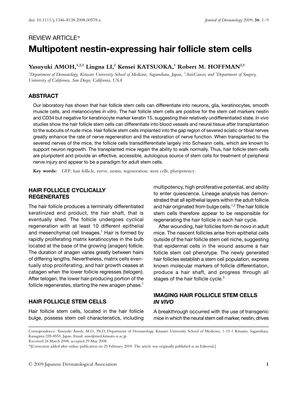TLDR Hair follicle stem cells can turn into various cell types and help repair nerves.
In 2009, researchers found that hair follicle stem cells expressing nestin and CD34 are multipotent, capable of differentiating into a variety of cell types such as neurons, glia, keratinocytes, smooth muscle cells, and melanocytes. These cells do not express keratin 15, confirming their undifferentiated state. In vivo experiments showed that when these stem cells were transplanted into nude mice with severed sciatic or tibial nerves, they promoted nerve regeneration and functional recovery, often becoming Schwann cells. This study suggests that hair follicle stem cells could be a viable and ethical source of autologous stem cells for peripheral nerve injury treatment and have potential applications in regenerative medicine. The document does not provide the number of subjects used in the study.
144 citations
,
June 2008 in “Cell Cycle” Hair follicle stem cells can help repair spinal cord injuries and improve walking.
80 citations
,
September 2007 in “Cell Cycle” Stem cells in hair follicles can become various cell types, including neurons.
 829 citations
,
May 2007 in “Nature”
829 citations
,
May 2007 in “Nature” Hair follicles can regrow in wounded adult mouse skin using a process like embryo development.
344 citations
,
June 2006 in “American Journal Of Pathology” 319 citations
,
November 2005 in “Proceedings of the National Academy of Sciences” Hair follicle stem cells can help repair damaged nerves.
1279 citations
,
November 2005 in “Nature Medicine” 419 citations
,
March 2005 in “Proceedings of the National Academy of Sciences” Hair-follicle stem cells can become neurons.
212 citations
,
August 2004 in “Proceedings of the National Academy of Sciences” Hair follicle cells can create new blood vessels in the skin.
268 citations
,
December 2003 in “Experimental Dermatology” Hair follicle cells can become fat and bone cells.
352 citations
,
August 2003 in “Proceedings of the National Academy of Sciences” Nestin is found in hair follicle progenitor cells, linking them to neural stem cells.
949 citations
,
January 2001 in “Cell” Adult mouse skin contains stem cells that can create new hair, skin, and oil glands.
1010 citations
,
August 2000 in “Cell” Hair follicle stem cells can form both hair follicles and skin.
6 citations
,
March 2011 in “European Journal of Dermatology” Nestin-positive cells are important for hair follicle regeneration in alopecia areata.

